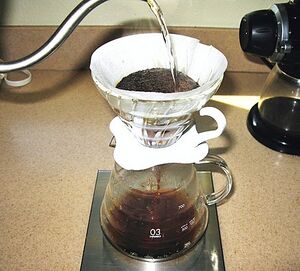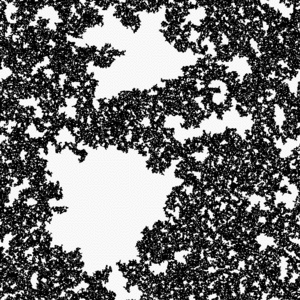“渗流”的版本间的差异
跳到导航
跳到搜索

| 第1行: | 第1行: | ||
| − | + | [[文件:Manual coffee preperation.jpg|替代=|缩略图|在咖啡过滤的时候,可溶性化合物离开咖啡渣并加入水形成[[咖啡]]。不溶性化合物(和颗粒)留在咖啡过滤器中。]] | |
| + | [[文件:Percolation.gif|替代=|缩略图|网格中的渗流。]] | ||
| − | + | [[File:Percolation.gif|thumb|在正方形格子中过滤(点击动画)|链接=Special:FilePath/Percolation.gif]] | |
| − | [[ | + | 在[[物理]]、[[化学]]和[[材料科学]]中, 渗流 '''Percolation'''指的是流体通过多孔材料的运动和过滤。 |
| − | |||
| − | |||
| − | |||
| − | |||
| − | |||
| − | |||
| − | |||
| − | |||
| − | |||
| − | |||
| − | |||
| − | |||
| − | |||
| − | |||
| − | |||
| − | |||
| − | |||
| − | |||
| − | |||
这是'''<font color = '#ff8000'>达西定律</font>'''所描述的。 | 这是'''<font color = '#ff8000'>达西定律</font>'''所描述的。 | ||
| − | |||
| − | + | 人们已经开发出了更广泛的可以描述以格子或图形为模型系统的连通性的应用,将其类比于过滤问题中渗流能力的调节。 | |
| − | |||
| − | == | + | ==背景== |
| − | |||
| − | + | 在过去的几十年里,'''渗流理论Percolation theory('''渗流的数学研究),给物理学、材料科学、'''复杂网络Percolation theory'''、'''流行病学'''和其他领域带来了新的理解和技术。例如,在'''地质学'''中,渗滤指的是水通过土壤和渗透性岩石的过滤。这些水流入地下水和蓄水层补给地下水。在计划排放大量水的渗滤池或化粪池的地方,需要事先进行渗流试验,以确定预期的结构是否可能实现。 | |
| − | + | 渗流作用具有典型的普遍性。[[统计物理概念]]中,如[[标度理论]],[[重整化]],[[相变]],[[临界现象]]和[[分形]]这些词语用于描述渗流特性。渗流是水在重力作用下,通过孔隙和土壤中的其他空间向下运动的描述。 | |
| − | |||
| − | |||
| − | |||
| − | |||
| − | |||
| − | |||
| − | |||
| − | |||
| − | |||
| − | |||
| − | |||
[[组合数学]]是研究[[渗流阈值]]的常用方法。 | [[组合数学]]是研究[[渗流阈值]]的常用方法。 | ||
| + | 由于从渗流分析模型获得精确结果非常复杂,人们通常使用计算机来进行模拟。目前最快的渗流算法是由[[马克 · 纽曼|马克 · 纽曼Mark Newman]]和[[罗伯特 · 齐夫|罗伯特 · 齐夫Robert Ziff]]在2000年发表的。<ref name="newman">{{cite journal |last=Newman |first=Mark |author-link=Mark Newman |last2=Ziff |first2=Robert |title=Efficient Monte Carlo Algorithm and High-Precision Results for Percolation |journal=[[Physical Review Letters]] |volume=85 |issue=19 |pages=4104–4107 |year=2000 |doi=10.1103/PhysRevLett.85.4104 |pmid=11056635 |arxiv=cond-mat/0005264 |bibcode=2000PhRvL..85.4104N |citeseerx=10.1.1.310.4632 }}</ref> | ||
| − | |||
| − | |||
| − | |||
| − | |||
| + | ==实例== | ||
| − | + | * 咖啡渗滤,其中溶剂是水,渗透性物质是咖啡渣,可溶成分是使咖啡具有颜色、味道和香气的化合物。 | |
| − | + | * 风化运动:地表下斜坡上风化物质的运动。 | |
| − | + | * 树木的开裂有两种情况的存在,阳光和压力的影响。 | |
| − | + | * 生物病毒壳对随机亚基去除的崩溃和鲁棒性(实验验证了病毒的碎片和拆卸)。<ref>{{Cite journal |doi = 10.1088/1478-3975/aac194|pmid = 29714713|pmc = 6004236|title = Molecular jenga: The percolation phase transition (collapse) in virus capsids|journal = Physical Biology|volume = 15|issue = 5|pages = 056005|year = 2018|last1 = Brunk|first1 = Nicholas E.|last2 = Lee|first2 = Lye Siang|last3 = Glazier|first3 = James A.|last4 = Butske|first4 = William|last5 = Zlotnick|first5 = Adam|bibcode = 2018PhBio..15e6005B}}</ref><ref>{{Cite journal |doi = 10.1002/pro.3265|pmid = 28795465|pmc = 5654856|title = A molecular breadboard: Removal and replacement of subunits in a hepatitis B virus capsid|journal = Protein Science|volume = 26|issue = 11|pages = 2170–2180|year = 2017|last1 = Lee|first1 = Lye Siang|last2 = Brunk|first2 = Nicholas|last3 = Haywood|first3 = Daniel G.|last4 = Keifer|first4 = David|last5 = Pierson|first5 = Elizabeth|last6 = Kondylis|first6 = Panagiotis|last7 = Wang|first7 = Joseph Che-Yen|last8 = Jacobson|first8 = Stephen C.|last9 = Jarrold|first9 = Martin F.|last10 = Zlotnick|first10 = Adam}}</ref> | |
| − | * | + | * 网络对随机和目标攻击的鲁棒性。<ref>{{cite journal |author=R. Cohen and S. Havlin|year=2010 |title=Complex Networks: Structure, Robustness and Function |journal=Cambridge University Press}}</ref> |
| − | * | + | * 多孔介质中的输送。 |
| − | * | + | * 疫情蔓延。<ref name="ParshaniCarmi2010">{{cite journal |last1=Parshani |first1=Roni |last2=Carmi |first2=Shai |last3=Havlin |first3=Shlomo |title=Epidemic Threshold for the Susceptible-Infectious-Susceptible Model on Random Networks |journal=Physical Review Letters |volume=104 |issue=25 |pages=258701 |year=2010 |issn=0031-9007 |doi=10.1103/PhysRevLett.104.258701 |pmid=20867419 |arxiv = 0909.3811 |bibcode = 2010PhRvL.104y8701P}}</ref><ref>{{cite journal |last1=Grassberger |first1=Peter |author-link1=Peter Grassberger |title=On the Critical Behavior of the General Epidemic Process and Dynamical Percolation |journal=Mathematical Biosciences |volume=63 |issue=2 <!-- |month=April -->|pages=157–172 |year=1983 |doi=10.1016/0025-5564(82)90036-0 }}</ref> |
| − | + | * 表面粗化。 | |
| − | + | * 牙齿渗漏,增加牙冠下的龋坏率,因为环境有利于链球菌突变体和乳酸菌的生长。 | |
| − | + | * 化粪池系统的潜在地点将通过“perk测试”进行测试。 | |
| − | * | + | * 例子:在地面上挖一个洞(通常直径6-10英寸)(通常12-24英寸深)。把水灌进洞里,以水滴在水面上一英寸为单位测量时间。如果水面迅速下降,就像通常在分级不佳的沙子中看到的那样,那么它是一个潜在的化粪池“沥滤场”的好地方。如果场地的导流能力很低(通常是粘土和壤土),那么这个场地是不可取的。 |
| − | + | * 交通渗流。<ref>{{cite journal |author=D. Li, B. Fu, Y. Wang, G. Lu, Y. Berezin, H.E. Stanley, S. Havlin|year=2015|title=Percolation transition in dynamical traffic network with evolving critical bottlenecks|journal=PNAS|volume=112|issue=3|pages=669–72|doi=10.1073/pnas.1419185112|pmid=25552558|pmc=4311803|bibcode=2015PNAS..112..669L}}</ref> | |
| − | * | ||
| − | |||
| − | * | ||
| − | |||
| − | * | ||
| − | |||
| − | * | ||
| − | |||
| − | * | ||
| − | |||
| − | * | ||
| − | |||
| − | * | ||
| − | |||
| − | |||
| − | |||
| − | |||
| − | |||
| − | |||
| − | |||
| − | |||
| − | |||
| − | |||
| − | |||
| − | |||
| − | |||
| − | |||
| − | |||
| − | |||
| − | |||
| − | |||
| − | |||
| − | |||
| − | |||
| − | |||
| − | |||
| − | |||
| − | |||
| − | |||
| − | |||
| − | |||
| − | |||
| − | |||
| − | |||
| − | |||
| − | |||
| − | |||
| − | |||
| − | |||
| − | |||
| − | |||
| − | |||
| − | |||
==References== | ==References== | ||
| 第136行: | 第49行: | ||
{{Reflist}} | {{Reflist}} | ||
| − | + | ==扩展阅读== | |
| − | |||
| − | == | ||
* [[Harry Kesten|Kesten, Harry]]; [http://www.ams.org/notices/200605/what-is-kesten.pdf "What is percolation?"], in ''[[Notices of the AMS]]'', May 2006. | * [[Harry Kesten|Kesten, Harry]]; [http://www.ams.org/notices/200605/what-is-kesten.pdf "What is percolation?"], in ''[[Notices of the AMS]]'', May 2006. | ||
| − | * Sahimi, Muhammad; ''Applications of Percolation Theory'', Taylor & Francis, 1994 | + | * Sahimi, Muhammad; ''Applications of Percolation Theory'', Taylor & Francis, 1994. |
* [[Geoffrey Grimmett|Grimmett, Geoffrey]]; ''[http://www.statslab.cam.ac.uk/~grg/papers/perc/perc.html Percolation (2. ed).]'' Springer Verlag, 1999. | * [[Geoffrey Grimmett|Grimmett, Geoffrey]]; ''[http://www.statslab.cam.ac.uk/~grg/papers/perc/perc.html Percolation (2. ed).]'' Springer Verlag, 1999. | ||
| − | * Stauffer, Dietrich ; and Aharony, Ammon; ''Introduction to Percolation Theory'', Taylor & Francis, 1994, revised second edition | + | * Stauffer, Dietrich ; and Aharony, Ammon; ''Introduction to Percolation Theory'', Taylor & Francis, 1994, revised second edition |
* Bunde, Armin; [[Shlomo Havlin|Havlin, Shlomo]] (editors); ''[http://havlin.biu.ac.il/Shlomo%20Havlin%20books_fds.php Fractals and Disordered Systems]'', Springer, 1996. | * Bunde, Armin; [[Shlomo Havlin|Havlin, Shlomo]] (editors); ''[http://havlin.biu.ac.il/Shlomo%20Havlin%20books_fds.php Fractals and Disordered Systems]'', Springer, 1996. | ||
| 第156行: | 第67行: | ||
* Rodrigues, Edouard; [http://www.jeudhex.com Remarkable properties of pawns on a hexboard] | * Rodrigues, Edouard; [http://www.jeudhex.com Remarkable properties of pawns on a hexboard] | ||
| − | * Cohen, Reuven; and Havlin, Shlomo; [http://havlin.biu.ac.il/img/book2009.pdf ''Complex Networks: Structure, Robustness and Function''], Cambridge University Press, 2010 | + | * Cohen, Reuven; and Havlin, Shlomo; [http://havlin.biu.ac.il/img/book2009.pdf ''Complex Networks: Structure, Robustness and Function''], Cambridge University Press, 2010 |
| − | |||
| − | |||
| − | |||
| − | |||
| − | |||
| − | |||
| − | |||
| − | |||
| − | |||
| − | |||
| − | |||
| − | |||
| − | |||
| − | |||
| − | |||
| + | * [http://havlin.biu.ac.il/course3.php Introduction to Percolation Theory: short course by Shlomo Havlin] | ||
[[Category:Systems theory]] | [[Category:Systems theory]] | ||
| − | |||
| − | |||
| − | |||
| − | |||
[[Category:Combinatorics]] | [[Category:Combinatorics]] | ||
| − | |||
| − | |||
[[分类: 组合数学]] | [[分类: 组合数学]] | ||
| − | |||
| − | |||
| − | |||
| − | |||
[[Category:待整理页面]] | [[Category:待整理页面]] | ||
2022年4月22日 (五) 22:26的版本

在咖啡过滤的时候,可溶性化合物离开咖啡渣并加入水形成咖啡。不溶性化合物(和颗粒)留在咖啡过滤器中。
在物理、化学和材料科学中, 渗流 Percolation指的是流体通过多孔材料的运动和过滤。
这是达西定律所描述的。
人们已经开发出了更广泛的可以描述以格子或图形为模型系统的连通性的应用,将其类比于过滤问题中渗流能力的调节。
背景
在过去的几十年里,渗流理论Percolation theory(渗流的数学研究),给物理学、材料科学、复杂网络Percolation theory、流行病学和其他领域带来了新的理解和技术。例如,在地质学中,渗滤指的是水通过土壤和渗透性岩石的过滤。这些水流入地下水和蓄水层补给地下水。在计划排放大量水的渗滤池或化粪池的地方,需要事先进行渗流试验,以确定预期的结构是否可能实现。
渗流作用具有典型的普遍性。统计物理概念中,如标度理论,重整化,相变,临界现象和分形这些词语用于描述渗流特性。渗流是水在重力作用下,通过孔隙和土壤中的其他空间向下运动的描述。
由于从渗流分析模型获得精确结果非常复杂,人们通常使用计算机来进行模拟。目前最快的渗流算法是由马克 · 纽曼Mark Newman和罗伯特 · 齐夫Robert Ziff在2000年发表的。[1]
实例
- 咖啡渗滤,其中溶剂是水,渗透性物质是咖啡渣,可溶成分是使咖啡具有颜色、味道和香气的化合物。
- 风化运动:地表下斜坡上风化物质的运动。
- 树木的开裂有两种情况的存在,阳光和压力的影响。
- 生物病毒壳对随机亚基去除的崩溃和鲁棒性(实验验证了病毒的碎片和拆卸)。[2][3]
- 网络对随机和目标攻击的鲁棒性。[4]
- 多孔介质中的输送。
- 疫情蔓延。[5][6]
- 表面粗化。
- 牙齿渗漏,增加牙冠下的龋坏率,因为环境有利于链球菌突变体和乳酸菌的生长。
- 化粪池系统的潜在地点将通过“perk测试”进行测试。
- 例子:在地面上挖一个洞(通常直径6-10英寸)(通常12-24英寸深)。把水灌进洞里,以水滴在水面上一英寸为单位测量时间。如果水面迅速下降,就像通常在分级不佳的沙子中看到的那样,那么它是一个潜在的化粪池“沥滤场”的好地方。如果场地的导流能力很低(通常是粘土和壤土),那么这个场地是不可取的。
- 交通渗流。[7]
References
- ↑ Newman, Mark; Ziff, Robert (2000). "Efficient Monte Carlo Algorithm and High-Precision Results for Percolation". Physical Review Letters. 85 (19): 4104–4107. arXiv:cond-mat/0005264. Bibcode:2000PhRvL..85.4104N. CiteSeerX 10.1.1.310.4632. doi:10.1103/PhysRevLett.85.4104. PMID 11056635.
- ↑ Brunk, Nicholas E.; Lee, Lye Siang; Glazier, James A.; Butske, William; Zlotnick, Adam (2018). "Molecular jenga: The percolation phase transition (collapse) in virus capsids". Physical Biology. 15 (5): 056005. Bibcode:2018PhBio..15e6005B. doi:10.1088/1478-3975/aac194. PMC 6004236. PMID 29714713.
- ↑ Lee, Lye Siang; Brunk, Nicholas; Haywood, Daniel G.; Keifer, David; Pierson, Elizabeth; Kondylis, Panagiotis; Wang, Joseph Che-Yen; Jacobson, Stephen C.; Jarrold, Martin F.; Zlotnick, Adam (2017). "A molecular breadboard: Removal and replacement of subunits in a hepatitis B virus capsid". Protein Science. 26 (11): 2170–2180. doi:10.1002/pro.3265. PMC 5654856. PMID 28795465.
- ↑ R. Cohen and S. Havlin (2010). "Complex Networks: Structure, Robustness and Function". Cambridge University Press.
- ↑ Parshani, Roni; Carmi, Shai; Havlin, Shlomo (2010). "Epidemic Threshold for the Susceptible-Infectious-Susceptible Model on Random Networks". Physical Review Letters. 104 (25): 258701. arXiv:0909.3811. Bibcode:2010PhRvL.104y8701P. doi:10.1103/PhysRevLett.104.258701. ISSN 0031-9007. PMID 20867419.
- ↑ Grassberger, Peter (1983). "On the Critical Behavior of the General Epidemic Process and Dynamical Percolation". Mathematical Biosciences. 63 (2): 157–172. doi:10.1016/0025-5564(82)90036-0.
- ↑ D. Li, B. Fu, Y. Wang, G. Lu, Y. Berezin, H.E. Stanley, S. Havlin (2015). "Percolation transition in dynamical traffic network with evolving critical bottlenecks". PNAS. 112 (3): 669–72. Bibcode:2015PNAS..112..669L. doi:10.1073/pnas.1419185112. PMC 4311803. PMID 25552558.
{{cite journal}}: CS1 maint: multiple names: authors list (link)
扩展阅读
- Kesten, Harry; "What is percolation?", in Notices of the AMS, May 2006.
- Sahimi, Muhammad; Applications of Percolation Theory, Taylor & Francis, 1994.
- Grimmett, Geoffrey; Percolation (2. ed). Springer Verlag, 1999.
- Stauffer, Dietrich ; and Aharony, Ammon; Introduction to Percolation Theory, Taylor & Francis, 1994, revised second edition
- Bunde, Armin; Havlin, Shlomo (editors); Fractals and Disordered Systems, Springer, 1996.
- Kirkpatrick, Scott; "Percolation and Conduction", in Reviews of Modern Physics, 45, 574, 1973.
- Ben-Avraham, Daniel; Havlin, Shlomo; Diffusion and Reactions in Fractals and Disordered Systems, Cambridge University Press, 2000.
- Rodrigues, Edouard; Remarkable properties of pawns on a hexboard
- Cohen, Reuven; and Havlin, Shlomo; Complex Networks: Structure, Robustness and Function, Cambridge University Press, 2010
